- Quick Read
- Deep Read ( 6 Min. )
In Today’s Issue
- Iran nuclear talks progress, but is it enough to save the deal?
- US is trying to stop mass shootings. How about other gun crimes?
- Wildfires, hurricanes, and cooperation in the Panhandle
- Their cup overflows: Why future is bright for Saudi coffee growers
- ‘They welcome us’: Diverse running clubs attract more to sport
Monitor Daily Podcast
- Follow us:
- Apple Podcasts
- Spotify
- RSS Feed
- Download
TODAY’S INTRO
An exonerated Detroit man defines normal as generosity
After nine years behind bars in Michigan, Davontae Sanford is a wealthy and grateful young man. But his path to prosperity wasn’t his choice.
When he was 15, Mr. Sanford pleaded guilty to second-degree murder in the shootings of four people in 2007. He took a plea deal, he said, only because he felt helpless and poorly represented by a lawyer. In 2016, Mr. Sanford was released after a professional hit man confessed in detail to the same murders and the law schools at the University of Michigan and Northwestern University got involved.
Earlier this year, Mr. Sanford reached a $7.5 million settlement agreement with the city of Detroit for his wrongful conviction and incarceration.
How many Davontae Sanfords are there? The percentage of wrongful convictions in the United States is somewhere between 2% and 10%, according to the 2019 annual report by the National Registry of Exonerations. That suggests the number of innocent people behind bars could be from 46,000 to 230,000.
Mr. Sanford is back in the news – this time for his expression of forgiveness, gratitude, and generosity. On Tuesday, he spent several hours giving away $25,000 in free gas for older people and women at a BP station in downtown Detroit. “It’s only right I give back to the city and I give back to the most vulnerable,” he told WJBK-FOX 2 news in Detroit.
“I want to be normal,” he said, adding that “normal” meant doing things that he couldn’t do while in prison. “Now I have the chance and opportunity, so I’m going to embrace them with gratitude.”
Now that’s an inspiring concept of “normal.”
Share this article
Link copied.

Help fund Monitor journalism for $11/ month
Already a subscriber? Login

Monitor journalism changes lives because we open that too-small box that most people think they live in. We believe news can and should expand a sense of identity and possibility beyond narrow conventional expectations.
Our work isn't possible without your support.
Iran nuclear talks progress, but is it enough to save the deal?
The latest round of negotiations between Iran and other nations has produced a surprise draft nuclear agreement. But can the parties find a way to rebuild enough trust to keep moving forward?

American and Iranian nuclear negotiators are returning to their capitals with a document offering a glimmer of hope for the embattled 2015 Iran nuclear deal, after the sudden resumption late last week of negotiations that had been deadlocked for months.
Details of the new text remain secret and must be approved by the United States, Iran, and the other five signatories. European Union officials said in Vienna the 25-page final document was the “best possible offer” and a “very good compromise.”
“What can be negotiated has been negotiated,” EU foreign policy chief Josep Borrell tweeted Monday. “Behind every technical issue and every paragraph lies a political decision that needs to be taken in the capitals,” he wrote. “If these answers are positive, then we can sign this deal.”
Yet if the nuclear deal is restored, it will have overcome soaring levels of mutual distrust triggered by then-President Donald Trump’s 2018 unilateral withdrawal, his campaign of renewed sanctions, and Iran’s expansion of its nuclear program well beyond the deal’s limits.
Nasser Hadian, a professor at Tehran University, last year presented bridging proposals to senior Iranian officials, who calculate that a restored deal won’t outlast the Biden administration. “There is no trust here at all,” he says.
Iran nuclear talks progress, but is it enough to save the deal?

American and Iranian nuclear negotiators are returning to their capitals with the final text of a document to restore the embattled 2015 Iran nuclear deal, after more than 15 months of European Union-brokered diplomacy in Vienna concluded with a final four-day round of talks.
The sudden resumption late last week of negotiations, which had appeared hopelessly deadlocked after a five-month delay, rekindled a glimmer of hope of a return to the landmark deal.
Under the original deal, negotiated by the Obama administration, Iran agreed to strict limits on its nuclear program and forswore pursuing an atomic bomb in exchange for the lifting of sanctions.
Yet if the Joint Comprehensive Plan of Action, or JCPOA, as the nuclear deal is formally called, is restored, it will have overcome soaring, perhaps unsurpassed, levels of mutual distrust.
The negative feedback cycle was triggered by then-President Donald Trump’s 2018 unilateral withdrawal of the United States, and his “maximum pressure” campaign of renewed and expanded sanctions, followed by Iran’s expansion of its nuclear program well beyond the limits of the deal.
If the parties fail to agree now on restoring the deal, analysts say the best result may be a hard-to-sustain cold peace, in which neither side chooses to escalate. Even if that balance is achieved, it would be vulnerable to enduring distrust and potential provocations – compounded by the actions of third parties like Israel, which continues to conduct high-profile assassinations and sabotage inside Iran – that could spark renewed escalation that risks war.
Waiting for answers
Details of the new text remain secret and must be approved by the U.S. and Iran, as well as by China, Russia, the United Kingdom, France, and Germany. EU officials said in Vienna the 25-page final document was the “best possible offer” and a “very good compromise.”
“What can be negotiated has been negotiated,” the EU foreign policy chief, Spain’s Josep Borrell, tweeted Monday.
“Behind every technical issue and every paragraph lies a political decision that needs to be taken in the capitals,” he wrote. “If these answers are positive, then we can sign this deal.”
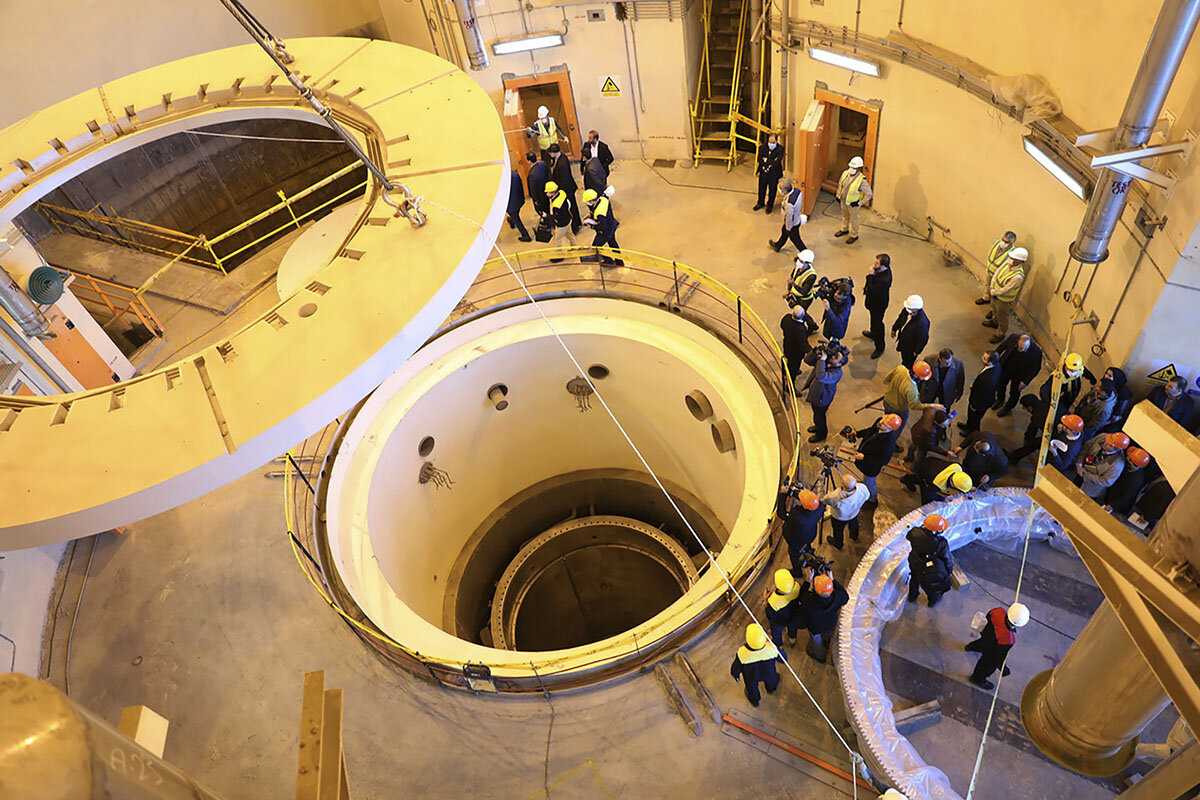
Such a result seemed highly unlikely even one week ago, for a moribund process beset in Iran by a dramatic political shift to wider hard-line rule that codifies anti-Western sentiment – coupled with supreme leader Ayatollah Ali Khamenei’s oft-stated conviction that Mr. Trump’s withdrawal is proof that Americans won’t stick to any deal.
On the U.S. side, President Joe Biden reversed a number of Trump-era rulings in his first days in office, had criticized Mr. Trump’s abandonment of the deal, and had promised a “longer and stronger” agreement that would limit Iran’s missile development and curtail regional activities – steps Iran long rejected.
Yet Mr. Biden waited months before launching efforts to restore the JCPOA and has left many Trump sanctions in place.
According to Ali Vaez, director of the Iran Project at the International Crisis Group, even before the resumption of talks, all parties were determined to avoid declaring the diplomatic process a failure. Yet, even with the new hint of progress, he says his level of optimism for a deal has increased from 5% last week to just 10% now.
Sticking points remain
Despite the reported development of creative mechanisms to address a multitude of issues on both sides, deadlock remains over questions by the United Nations’ nuclear watchdog agency, the International Atomic Energy Agency (IAEA), into decades-old, undeclared traces of human-made uranium particles found at several sites in Iran. The Islamic Republic wants the probe halted.
“It’s true that the negotiators took one step forward and made progress on guarantees and sanctions on [Islamic Revolutionary Guard Corps, or IRGC] companies, but they remain stuck over the IAEA’s safeguards probe,” says Mr. Vaez.
“Iran doesn’t seem to believe that time and solutions for a breakthrough are exhausted by now,” he adds. “That is why it has allowed so many opportunities for a settlement to slip away.”
“There is plenty of blame to go around; everybody committed mistakes,” says Mr. Vaez. “The Biden administration overlooked how much Trump’s withdrawal from the agreement eroded the little trust the Iranians had in the U.S.’s reliability as a negotiating partner [and] how damaging it was on the Iranian psyche.”
The result for Ayatollah Khamenei is a “fool-me-twice syndrome,” says Mr. Vaez, such that “reputational costs” for his legacy would be damaging to again endorse a nuclear deal if the U.S. can withdraw anytime, without cost.
Hard-line media in Iran have been unrelenting in disparaging any return to a deal they characterized as a giveaway of Iran’s nuclear jewels, with few economic benefits, by a naive, reform-leaning president, Hassan Rouhani.
“The JCPOA is already dead, they just simply refuse to pronounce it so,” wrote hard-line political analyst Alireza Taqavinia last week on the conservative Jomhouriat website.
“There is no trust here at all,” says Nasser Hadian, a professor of political science at Tehran University, who last year presented bridging proposals to senior Iranian officials. They calculate that a restored deal won’t outlast the Biden administration, he says.
Among Professor Hadian’s proposals were several designed to deter a future U.S. pullout from the deal, such as keeping the bulk of Iran’s existing stockpile of enriched uranium in the country under IAEA seal and monitoring – instead of excess beyond the 300 kg limit of the deal being shipped abroad, as required by the original JCPOA.
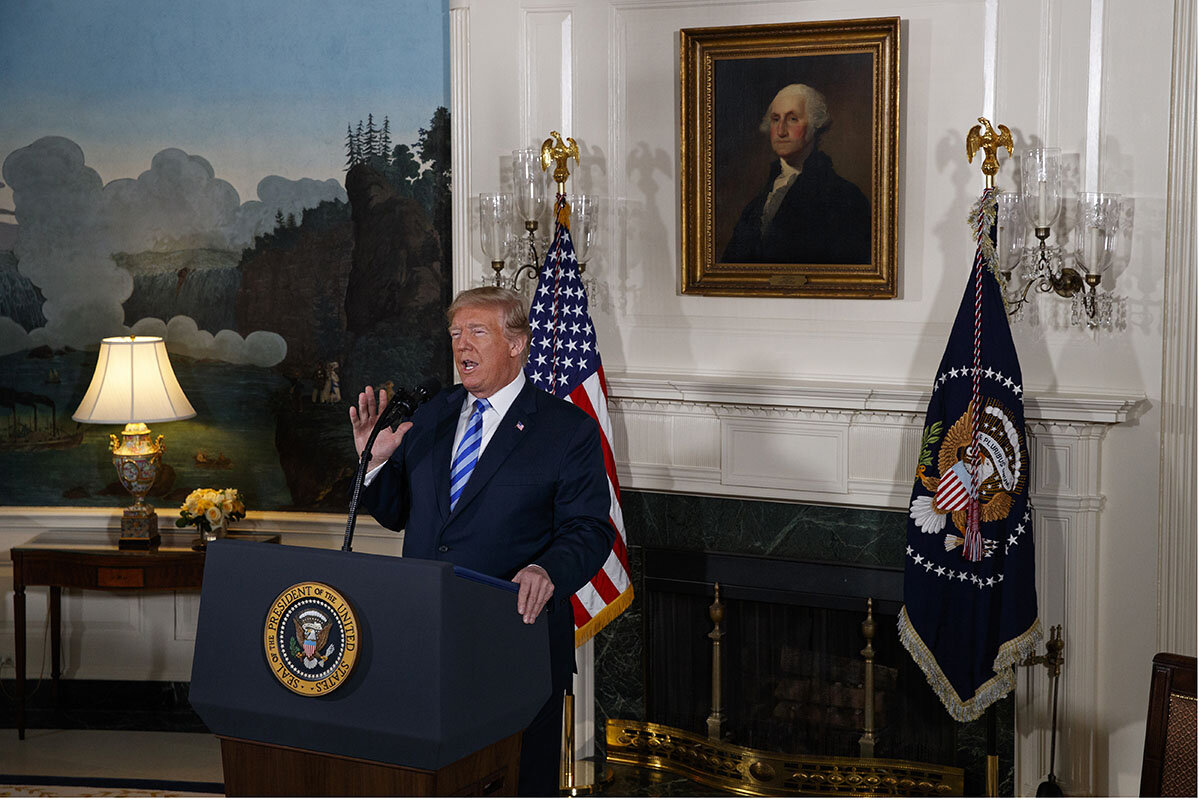
If the U.S. withdrew, Iran would then be able to immediately access that stockpile, which is currently large enough, if further enriched, to theoretically produce several nuclear warheads. Iran says it rejects nuclear weapons as forbidden by Islam, and has no known means of fashioning a warhead, much less delivering one – advances that usually take years.
A verification mechanism would also be created to ensure that economic benefits were being realized, says Professor Hadian, all aimed at “making it more difficult for the next U.S. president to withdraw from the deal.”
Sanctions and stockpiles
From the start, both sides’ demands to restore the deal were unrealistic to the other.
Iran wanted scores of billions of dollars in compensation – Professor Hadian says a “conservative” estimate is $240 billion – for losses incurred by the U.S. pullout, a guarantee that no future American president could again abandon the deal, and the lifting of all sanctions, including removing the IRGC terrorist designation.
The U.S., in its turn, demanded that Iran reverse its violations and put its nuclear genie back in the bottle by once again shrinking its stockpile of nuclear material, mothballing advanced centrifuges, and bringing uranium enrichment levels back down to 3.67% purity – as required in the original JCPOA – after raising them to a new high of 60%, which is a short technical step from weapons-grade 90% purity.
Senior EU officials Monday said “all the questions have been answered in the best possible way” in final draft text that produces economic benefits for Iran, while preserving the nonproliferation goals of global powers.
Seven years ago, then-President Barack Obama announced the nuclear deal, saying it overcame decades of mutual distrust precisely because it was “not built on trust; it is built on verification.”
But both the U.S. and Iran have sizable hard-line factions opposed to any deal, no matter how mutually beneficial. And since the JCPOA was first agreed, politics have shifted on both sides, and Iran’s nuclear advances have made finding a new formula acceptable to all a challenge.
For Iran, “the JCPOA in 2015 was a policy and goal in itself, but in 2022 the JCPOA is a means to achieve a different policy – and that policy is neutralizing sanctions,” says Adnan Tabatabai, head of the Germany-based Middle East think tank CARPO, the Center for Applied Research in Partnership with the Orient.
Mr. Tabatabai, who travels frequently to Iran, says Tehran aspires as a “new ambition” to have an economy strong enough to be “immune to the carrots and sticks of sanctions. That means the leadership may deem even a temporary JCPOA restoration worth it to help boost an economy that has been battered by sanctions and mismanagement.
“This negotiating team has to sell it at home as a success, and that success must mean attaining a goodie from the U.S. that compensates for the U.S. ... not giving guarantees,” he says.
“Trust is probably at its lowest level,” he adds. “The JCPOA experience ... has been really catastrophic, and we haven’t really digested, or understood, or acknowledged the scope of how disastrous this has been.”

US is trying to stop mass shootings. How about other gun crimes?
Mass shootings get the attention. But far more Americans die in urban gun violence each year. Our reporter looks at the problem and possible solutions, in light of the first major gun safety law passed by Congress in 30 years.

- Quick Read
- Deep Read ( 8 Min. )
For Janet Rice, the Sheldon Oaks Apartments in Hartford, Connecticut, hold a lot of memories. This is where her son Shane took his first steps. It is also where, almost two decades later, he took his last steps. The young entrepreneur had stopped by to pick up a payment from a car sale when a fight broke out at the apartment and he was shot.
The whole city is full of memories like this for Ms. Rice.
“Since losing my son, I’ve lost a nephew on the streets of Hartford. I lost my godson just last year,” she says. “The person who shot him was his friend – someone who sat at his mom’s kitchen table and shared dinner.”
For the first time in three decades, Congress passed legislation aimed at reducing gun violence, after a spate of mass shootings shook the nation. Nineteen children getting killed inside their classroom is the “kind of cataclysm that moves people to action,” Connecticut Sen. Chris Murphy, a lead negotiator for the bill, told the Monitor.
Ms. Rice applauds the measure and hopes it will prevent more mass shootings. But she doesn’t believe it will have much impact on communities like hers and the gun violence that happens there “every single day.”
US is trying to stop mass shootings. How about other gun crimes?
For Janet Rice, the Sheldon Oaks Apartments in downtown Hartford, Connecticut, hold a lot of memories. This is where her son Shane took his first steps. It is also where, almost two decades later, he took his last steps.
In October of 2012, Shane Oliver had just started a small business fixing up and reselling used cars. He’d gone back to the Sheldon Oaks with his girlfriend to pick up the remaining balance on a sale. A fight broke out. Mr. Oliver, then 20 years old, was shot and killed.
The whole city is full of memories like this for Ms. Rice.
“Since losing my son, I’ve lost a nephew on the streets of Hartford. I lost my godson just last year,” she says. “The person who shot him was his friend – someone who sat at his mom’s kitchen table and shared dinner.”
This summer, for the first time in three decades, Congress passed legislation aimed at reducing gun violence, after a spate of mass shootings shook the nation – including one at a grocery store in Buffalo, New York, and another at an elementary school in Uvalde, Texas. Nineteen children getting killed inside their classroom is the “kind of cataclysm that moves people to action,” Connecticut Sen. Chris Murphy, a lead negotiator for the bill, told the Monitor.
The Bipartisan Safer Communities Act will provide funding for states to implement red flag laws, enhance screening processes for gun purchasers under the age of 21, and prevent those convicted of domestic abuse from owning a gun for a period of time, along with channeling billions of dollars into mental health and school safety.
Ms. Rice applauds the measure and hopes it will prevent more mass shootings like the one in Uvalde. But she doesn’t believe it will have much impact on communities like hers and the gun violence that happens there “every single day.”
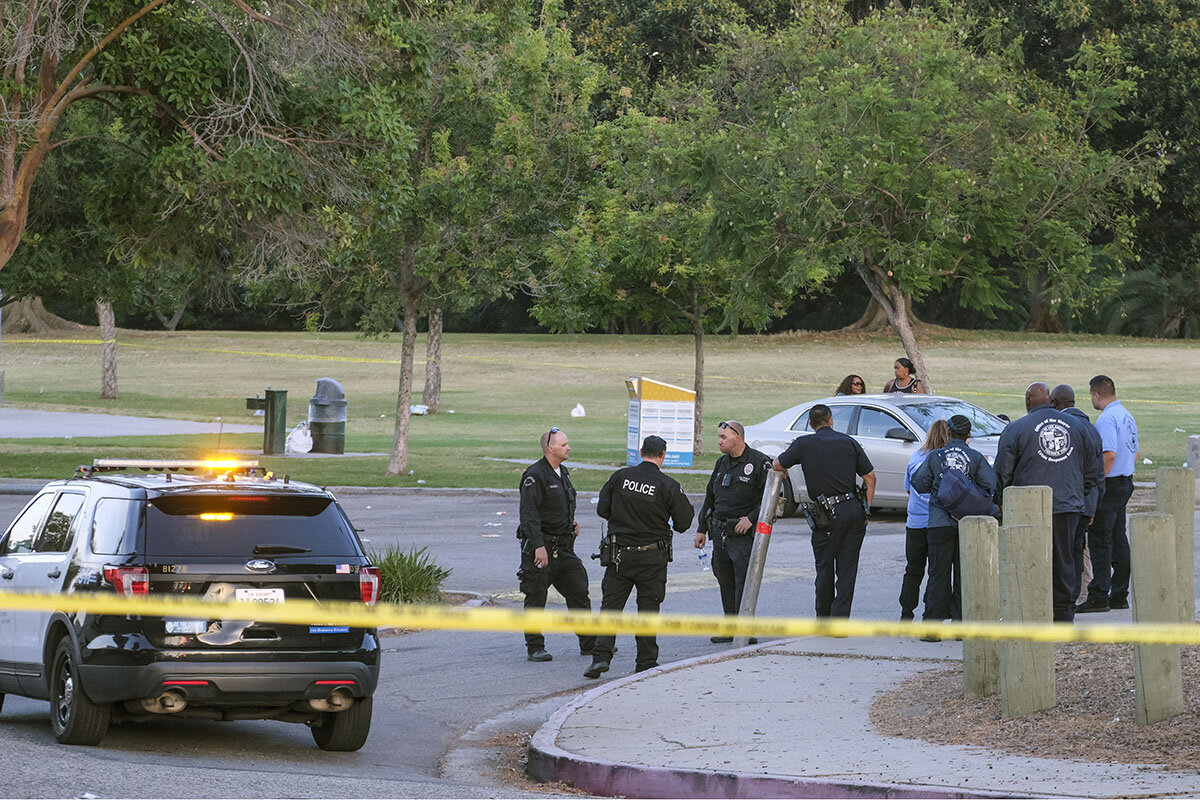
Activists and experts cite a variety of measures they think would help address the problem, from community policing to gun licensing laws. But first, many say, there needs to be a broader acknowledgement of the prevalence of this type of gun violence – and the lower-income, majority Black neighborhoods that are most impacted by it. Mass shootings – which comprised 38 of the record 45,222 U.S. gun deaths recorded by the FBI in 2020 – receive an outsize proportion of public attention due to their shocking nature. To make communities like Hartford safer, they say, would require sustained attention to the other kind of violent crime that too often is ignored.
Over the Fourth of July weekend, for example, the news media was focused on a mass shooting at a parade in the high-income, white Chicago suburb of Highland Park, Illinois, in which seven people were killed and 46 injured. But there were fewer reports about what occurred that same weekend some 30 miles south, where 10 people were killed and 62 were injured across dozens of shootings on Chicago’s South Side.
“I think America is taking mass shootings seriously, but I don’t think they’re taking community-level gun violence seriously,” says Ms. Rice. “And that needs to change.”
While they are talked about a lot, there is no set definition for mass shootings. The FBI defines “mass murder” as four people killed, which can include gun crimes. Other groups, such as the Gun Violence Archive, include incidents in which four people are injured, even if no one dies. Even with that more expansive definition, fewer than 2% of the almost 27,000 people killed by guns in the U.S. so far this year were victims of a mass shooting. More than half were suicides, which typically make up the largest share of gun deaths. The rest, various data sets suggest, were killed in incidents like the one in which Ms. Rice’s son lost his life.
After declining for decades, homicides began rising again in 2018. In 2020 and 2021, both the murder rate and violent crime spiked sharply, as the pandemic shuttered businesses and led to an increase in drug and alcohol use. Murder rates in cities rose by more than 30%, more than two-thirds of which were committed with a firearm.
Official data for 2022 is not yet available, but a recent compilation of national data by The New York Times found a slight downtick in the murder rate this year of about 3%. Still, many cities, including Hartford, have reported similar rates of gun crimes this summer compared with last.
“It just snowballs”
Experts point to many reasons for the relative lack of attention given to this type of gun violence, from the numbing effect of a steady drumbeat of incidents, to the fact that they tend to occur in low-income neighborhoods and among marginalized groups.
An analysis of 2020 data, the most recent available, from the Centers for Disease Control and Prevention, found that Black men between the ages of 15 and 34 were over 20 times more likely to be victims of gun homicide than their white counterparts. Put another way, although this demographic represents 2% of the total U.S. population, it accounts for almost 40% of all gun fatalities in 2020, according to a study by the Johns Hopkins Center for Gun Violence Solutions released in April. According to FBI data from 2019, almost 90% of Black homicide victims were killed by Black offenders – a high rate of intraracial violence that is also seen in white and other racial groups.
Activists say that fact has made some politicians reluctant to highlight the problem, out of a fear of perpetuating racist tropes.
“It shouldn’t be looked at as ‘Black on Black violence.’ It should be looked at as violence in neighborhoods that face a lack of human resources,” says Jeremy Stein, executive director of CT Against Gun Violence.
Many also acknowledge there’s a sense of hopelessness that can set in as violent incidents occur with growing frequency. Local activists in Hartford, a majority Black and Latino city with stark racial and wealth divides, say gun violence there is part of an interconnected cycle of poverty, hunger, poor education, housing shortages, and crime.
“There are ‘mass shootings’ happening in our neighborhoods all of the time,” says Jacquelyn Santiago Nazario, the CEO of Compass Youth Collaborative, a nonprofit in Hartford aimed at helping at-risk youth. “Thankfully people aren’t always hurt, but you have to understand that even hearing those gunshots creates a ripple effect of fear and trauma within the community that is not easily remedied.”
Compass connects mentors – whom they call peacebuilders – with young people to help them stay in school, find job opportunities, and navigate the same neighborhood conflicts they themselves experienced. In a brightly painted building behind the Compass office, several teens joke around with older men in orange peacebuilder shirts. Some are sprawled on the floor munching on doughnuts while others work with tutors. According to internal data collected by Compass, 89% of the youths they work with have lost family members or friends to homicide.
Ayelet Chozick, a director at Compass, tells the story of a young man who was shot and then went out and bought a gun because he felt the need to protect himself. He was then charged with possessing a gun and wound up in the juvenile justice system.
“It just snowballs,” says Ms. Chozick, “and you get caught up in that cycle of violence.”
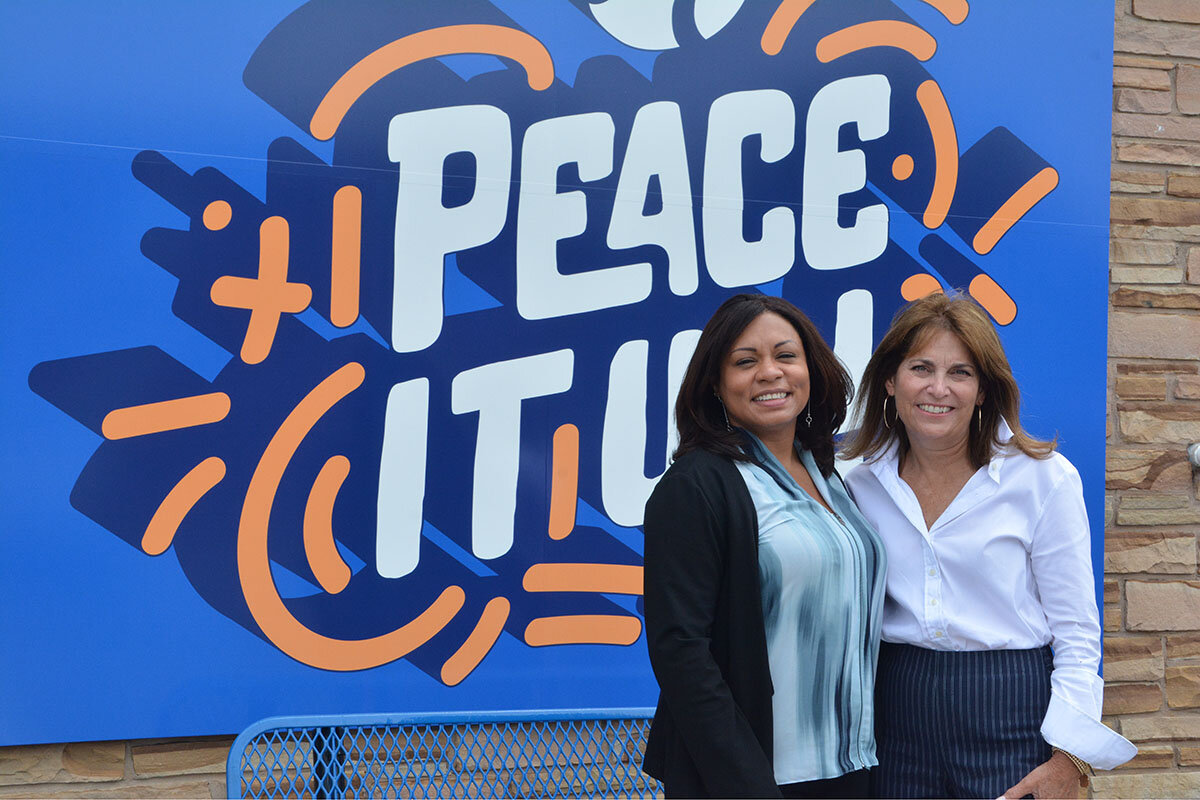
From biometrics to community policing
One ongoing challenge is that there has been little agreement about how best to address this problem legislatively.
While many activists say they would happily support reinstating an assault weapons ban like the one that expired in 2004, they also recognize that those are not the weapons used in most instances of community gun violence. “That’s not what killed my son,” says Ms. Rice.
At the same time, although the guns used in domestic violence, suicides, and mass shootings are often obtained legally, much of the violence plaguing cities like Hartford comes from guns obtained illegally through social networks or underground distributors.
For this reason, Odis Johnson, a social policy professor at Johns Hopkins University and part of their Center for Gun Violence Prevention and Policy, advocates for harsher penalties for illegal gun distributors and biometric finger locks on guns so they can only be used by their owner.
And because many of these guns are brought to cities like Hartford by underground distributors who travel across state lines, some advocates like Ms. Chozick are pushing for nationwide laws over state initiatives.
Mr. Stein, with CT Against Gun Violence, hopes federal lawmakers will turn to passing enhanced background checks for purchasers as their next piece of gun safety legislation.
The other crucial element, as most see it, is enhanced policing.
After the 2020 murder of George Floyd by police in Minneapolis, many liberal protesters across the country advocated for “defunding” or dismantling police departments – a stance that generated a backlash as violent crime spiked, and which some Democrats running for office are now taking pains to renounce.
Polling shows police divestment was always a far more popular policy among white Democrats. According to a 2021 Pew poll, Black and Hispanic Democrats were more likely than white Democrats to say police spending in their neighborhood should be increased, not decreased.
Almost all gun safety experts speak to the value of community policing, along with violence prevention programs that can stop the shooting before it begins. The Bipartisan Safer Communities Act allocated $250 million for community-based violence prevention initiatives like Compass. Still, that pales compared to the $5 billion President Joe Biden would have allocated for it in his failed Build Back Better agenda.
“That’s probably the smallest amount that passes muster as a serious response,” says Thomas Abt, a senior fellow on the Council on Criminal Justice and author of the book “Bleeding Out: The Devastating Consequences of Urban Violence – and a Bold New Plan for Peace in the Streets.” ”On the other hand, it’s more than we’ve seen in the past.”
Some say the mere fact that Congress did something this year to combat mass shootings – even if it doesn’t directly address community gun violence – is significant and could lead to further progress.
“There is no way we can curb everyday violence without first having these provisions in place that make it a little bit more difficult for those who shouldn’t have guns to be able to get them,” says Professor Johnson of Johns Hopkins. “It tends to be the case that when we have an event where the nation feels invested in a solution – such as mass shootings – that we finally get to a point where we actually meet some of the needs of these urban centers that have been trying to contend against gun violence for so long.”

Wildfires, hurricanes, and cooperation in the Panhandle
Climate change is creating conditions that make for bigger, more frequent wildfires. Our reporter looks at some of the ways to combat the problem in the Florida Panhandle.

- Quick Read
- Deep Read ( 7 Min. )
-
By Xander Peters Special correspondent
Hurricane Michael came first. The Category 5 storm made landfall in the Florida Panhandle on Oct. 10, 2018. Its 160 mph winds left 72 million tons of trees broken or blown over across a vast swath of mostly rural land.
Then came the Chipola Complex wildfires. Sparked in the same area early this March, they feasted on the debris still lying on the ground. Some acres in their path had 10 times the amount of burnable fuel available in a typical Panhandle forest.
“The severity that you saw and the track that it followed, it was directly related to Hurricane Michael,” says Ajay Sharma, a University of Florida researcher who focuses on forest management.
Eventually rains helped put out the fires. But climate change could increase the number of double-headed crises like this one, where the wood wreckage from one climate-related disaster had lain in the Panhandle for years, waiting for a spark to produce another.
Florida is awake to the risk and trying to respond.
The Florida Forest Service launched a public service campaign earlier this year to help residents better prepare their yards and homes, as well as suggested supplies for emergencies. And timber-recovery block grants, like the one allocated in 2019 that is helping pay for debris removal, could help as well.
Wildfires, hurricanes, and cooperation in the Panhandle

Jody Daniels has witnessed a fire or two in his life spent in the Florida Panhandle. He spent years fighting back flames at the side of his father, who was the volunteer fire department chief in unincorporated Kinard for four decades. Now he’s the fire chief himself.
But Mr. Daniels had never witnessed anything like the Bertha Swamp Road Fire that erupted in their region in early March. The fire broke out on a Friday, he remembers. In less than a week, it spread across roughly 34,000 acres, according to state estimates. As aircraft dumped fire retardants on the inferno that week, Mr. Daniels realized their small crew of volunteers and emergency personnel was among the last lines of defense between the flames and their neighbors’ homes.
“Next thing you know, it’s knocking at your back door. It’s coming,” Mr. Daniels says.
Mercifully, the crisis in Kinard was averted when rains came and the fire died down. But even so, the Chipola Complex fires – composed of the Bertha Swamp Road Fire and two others – were a conflagration that state fire managers had long feared. Fast burning and hard to fight, they fed on a tremendous swath of dry timber felled by Hurricane Michael in 2018. Fuel available for the fires to burn was 10 times greater than normal.
In other words, the wood wreckage from one climate-related disaster had lain in the Panhandle for years, waiting for a spark to produce another. It’s the sort of complex interaction between environmental events that could become more common as climate change leads to more extreme weather. Cooperation across government agencies and within communities can help, but the challenges are considerable.
“It’s very difficult to prepare for something so catastrophic,” says Erin Albury, director of the Florida Forest Service, in an email.
Fire and wind
Globally, wildfires are becoming more frequent. A February United Nations report projected as much as a 50% increase in wildfires breaking out worldwide by the dawn of the 22nd century.
In the United States much of the attention drawn by fires focuses on the burning American West, a dry region subject to fierce summer storms. For several weeks California firefighters have been battling the Oak Fire, which has spread across more than 19,000 acres and destroyed more than 100 homes since igniting near Yosemite National Park in late July.
But the threat of wildfires is not exclusive to the West, scientists warn. Already, threats of wildfires are on the rise in the southeastern U.S., despite the region’s long history of using prescribed burning to control forest undergrowth, which helps manage wildfire threats.
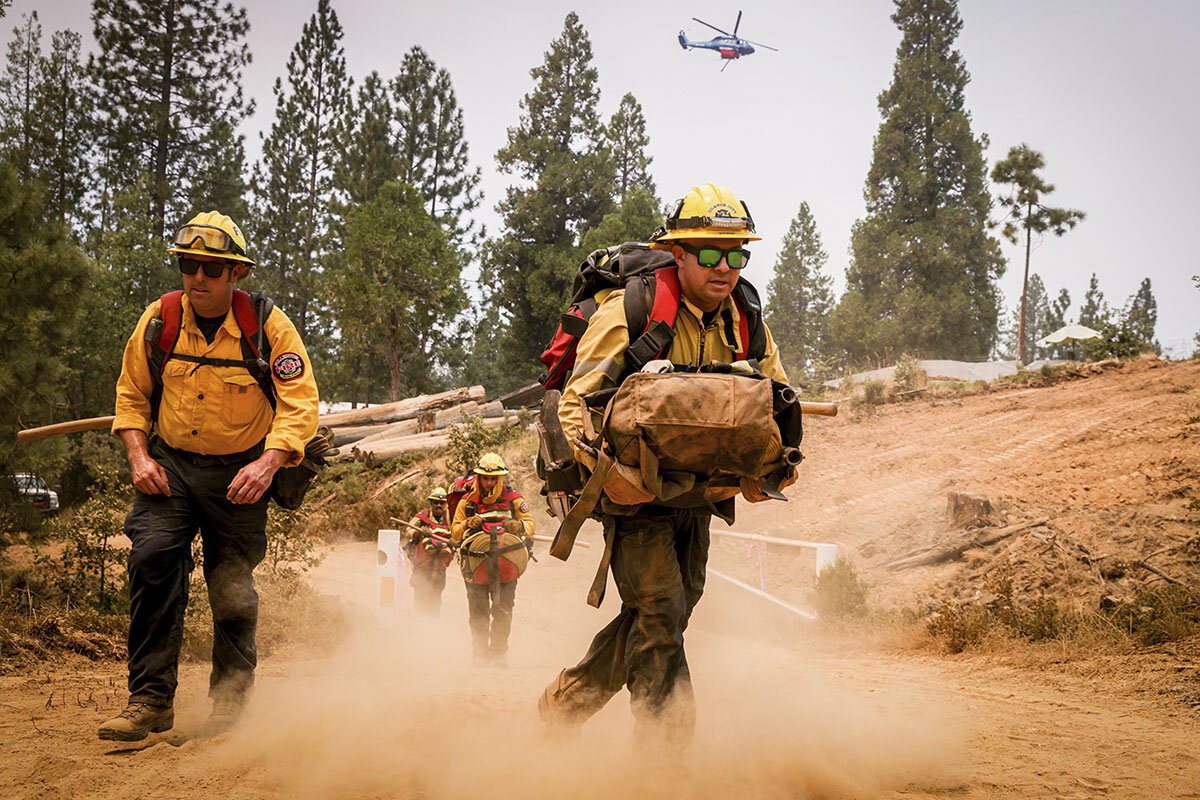
Researchers say the trend is likely to continue as droughts increase in severity. In fact, a report produced this year by the climate-risk modeling group First Street Foundation found that the risk of wildfires in the Panhandle is projected to increase from low to moderate to borderline major over the next 30 years.
Meanwhile, the threat of hurricanes and other powerful storms also appears to be increasing. The warming of bodies of water like the Atlantic Ocean and Gulf of Mexico due to climate change is making storms more powerful, say scientific experts.
The Florida Panhandle is one of the regions of the U.S. most susceptible to this growing threat, due to its location on the turbulent Gulf of Mexico. Annually, the Panhandle’s coastal counties have a 34% to 35% chance of getting hit by a storm powerful enough to be named by the National Weather Service, according to a forecast by the Colorado State University Tropical Weather and Climate Research group. Annual average probability of being hit by a major hurricane is 3% to 4%.
This summer in the Panhandle, where the annual fire season runs from March through June, storm damage and fire combined to produce an explosive result.
A tinderbox
Hurricane Michael set the scene a few years earlier. It made landfall in the region near Tyndall Air Force Base in the Panhandle on Oct. 10, 2018, as a Category 5 storm – the highest rating – with maximum sustained winds of 160 mph.
By some measures it was the third most intense Atlantic hurricane to ever hit the U.S. The area it struck contained some of the most forested counties in Florida, and Michael went through them like a giant chain saw, leaving 72 million tons of trees broken or blown over across a swath of 2.8 million acres, according to Florida Forest Service estimates.
Ordinarily, in Florida, the fuel load of a forest – the amount of burnable material it contains – is less than 10 tons per acre. After Michael, the area it churned over contained upward of 100 tons per acre. In most fires in the region, ground cover and understory vegetation burn. Michael left entire forests dead and drying on the ground.
Four years later, most of that debris remained. In the early days of March, three different wildfires sparked up in the region. Driven by strong winds, they grew quickly. Florida authorities named them the Chipola Complex.
A tinderbox was waiting in its path, forestry experts say.
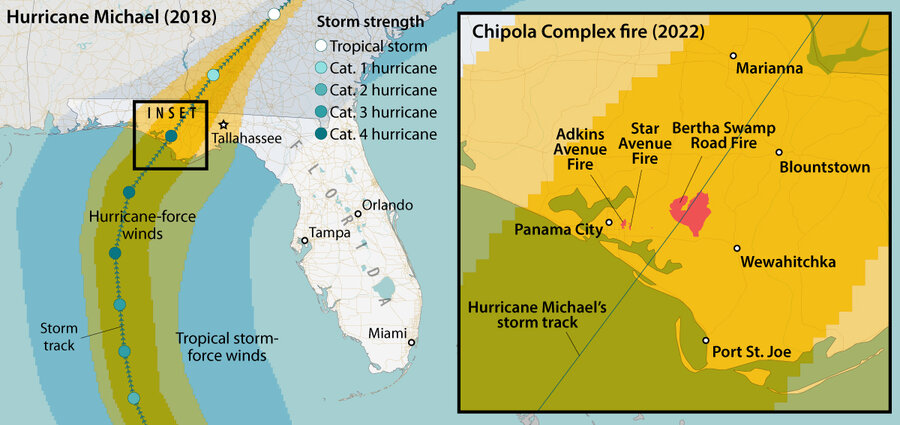
NOAA, National Interagency Fire Center
“The severity that you saw and the track that it followed, it was directly related to Hurricane Michael,” says Ajay Sharma, a University of Florida researcher who focuses on silviculture and restoration to inform forest management. “It would not have otherwise been that severe.”
Forestry officials admit their lack of options in responding to such a crisis. Nearly four years after Michael made landfall, costing Florida’s timber industry an estimated $1.2 billion, officials say it remains difficult to assess just how much of the storm debris has been removed.
Mr. Albury, the state Forest Service’s director, notes that only 10% of the debris felled during the storm was removed within six months of Michael making landfall. And since most of the impact occurred on privately owned lands, calculating what remains has proved difficult.
Along with fueling the flames, debris on the ground makes fighting fires more difficult.
“The size and volume of the fuels on the grounds make tractor operation and fire line establishment more difficult and extremely dangerous,” Mr. Albury says.
He notes how a typical 20-acre fire needs perhaps two tractors and two hours to contain. In terrain such as that left by Hurricane Michael, personnel need upward of a half-dozen bulldozers and as long as two or three days to get the same result.
“The Chipola Complex fires earlier this spring were a worst-case scenario,” Mr. Albury says.
Curbing double-pronged threats
State forestry departments face a daunting task in curbing double-pronged threats like the Panhandle’s Chipola Complex fires. Whereas post-hurricane cleanups are mandated for public lands – and government funding is allocated to pay for them – private landowners have little incentive to haul away debris. Many don’t live near the land in question.
To better understand how to meet in the middle of forestry management and private landowners’ needs, Dr. Sharma and his colleagues are currently conducting a survey of nonindustrial, private landowners in the region’s 10 rural counties directly impacted by Hurricane Michael. So far, they’ve learned that the average private landowner is 68 years old and retired. Only half live on their property, and almost all of the private landowners included in the survey are uninterested in harvesting timber. Roughly three-quarters of private landowners lack a forest management plan.
“Think about it,” Dr. Sharma says. If a powerful storm makes landfall and damages a forest area, retired landowners who don’t depend on timber investment will not be inclined to spend money to clear the land.
But “if there is a timber-recovery block grant that pays for it, they might do it,” Dr. Sharma says.
“It should fall under FEMA,” he adds. “Infrastructure needs to be in place.”
Already, state officials are attempting to fill that gap before next year’s fire season. One example Mr. Albury notes is the Florida Department of Agriculture’s $380 million timber-recovery block grant, allocated in 2019. So far, roughly $200 million of the grant has been distributed.
The Florida Forest Service also launched a public service campaign earlier this year to help residents better prepare their yards, their homes, and supply kits before the next season.
“We weren’t just going to cower down”
Fire season is a part of life in the Florida Panhandle. It’s been part of Mr. Daniels’ entire life so far.
As the Bertha Swamp Road Fire barreled toward homes in March, jumping through patches of forest and burning so hot it seared the cool, moist soil, small-town Kinard didn’t run. Rather, the community leaped into action. Those who owned a tractor raced into the outskirts of the inferno to plow dirt paths around folks’ homes, in an effort to divert the fires if they spread farther in their direction. Those who couldn’t run a tractor passed out drinks and brought food to the fire station.
Mr. Daniels realized he could lose everything if they failed to contain the fire. He fought harder.
“As a community, we weren’t just going to cower down and run from it,” Mr. Daniels says of how the community took up arms to contain the fire.

NOAA, National Interagency Fire Center

Their cup overflows: Why future is bright for Saudi coffee growers
In Saudi Arabia, locally grown coffee is often a symbol of hospitality, a beverage that brings joy and builds relationships. Now, our reporter finds, it’s slowly becoming a prized export.

- Quick Read
- Deep Read ( 6 Min. )
In remote villages of the Jazan region on the mountainous Saudi-Yemeni border, coffee has been many things over the centuries: a symbol of hospitality, a means of peacemaking, even a currency. Now, an ambitious new plan by the Saudi government envisions yet another role for this ancestral crop: a national industry aiming to fill your next morning cup.
With the government pitching prosperity for one of the oldest, if unheralded, coffee-growing regions in the world, farmers are looking for the first time to share their generations-old passion for Arabica khawlani coffee beyond their borders.
The drive to build a local industry coincides with the explosion of specialty coffee consumption in the kingdom. With the recent expansion of social freedoms have come thousands of new cafes – and a more discerning taste for coffee.
Kal Coffee, a Jeddah-based importer and wholesaler, and the kingdom’s first licensed coffee-quality evaluator, has witnessed a surge in demand for single-origin-sourced coffee from various countries. Most in demand? Homegrown.
Kal recently assessed a new brand of Jazan coffee. Says Kal director Abdullah Bagaba, “Frankly speaking, the results were stunning. They have very good coffee, and there is still huge room to improve.”
Their cup overflows: Why future is bright for Saudi coffee growers
Gibran al-Maliki walks through clouds and into the tree-lined stone terraces hugging the mountainside – treading the same path his family has walked for generations.
He stops to bend down and gently squeeze a sapling’s green-red cherry between his fingers. Ripening too fast, he says.
“Seven centuries and the farming process is still the same,” he smiles, “and the joy is still the same.”
Here in the remote villages dotting the mountains of the Saudi-Yemeni border, coffee has been many things over the centuries: a symbol of hospitality, a community uniter, a means of celebrating and peacemaking, and a currency.
Now, an ambitious new plan by the Saudi government envisions yet another role for this ancestral crop: a national industry aiming to fill your next morning cup.
Amid government pitches of prosperity for rural communities, these farmers are looking for the first time to share their generations-old passion for Arabica khawlani coffee with the world. Yet locals say tradition, as much as market economics, will determine Saudi coffee’s future success.
The big plans for Saudi Arabia’s small-time coffee farms are the vision of the Saudi Coffee Company, an entity formed and launched in May by the government’s Public Investment Fund, which aims to pour $320 million into the fledgling coffee sector over the next 10 years and grow an additional 900,000 Arabica trees. Currently there are 200,000 coffee trees under cultivation in the Jazan area among the 400,000 overall in southwest Saudi Arabia.
With dreams of boosting national production from the current modest 300 metric tons to 2,500 metric tons by 2032, they are tapping into one of the oldest, if unheralded, coffee-growing regions in the world.
Yet here in Jazan in southwest Saudi Arabia, which, along with neighboring Yemen, hosts some of the oldest coffee trees in the world, growing, harvesting, and brewing coffee is still largely seen as a joy to be shared, rather than a business to profit from.
Uncle Gibran’s farm
One of the first in Jazan’s Al Dayer area to turn his love of coffee into a local business is Mr. Maliki who, upon retiring from teaching in his remote mountaintop village of Al Qateel in 2007, looked to revive his family farms at 1,500 meters (about 4,900 feet) above sea level.

“I decided to plant coffee not because I thought the future was in Saudi coffee, but because coffee is what I grew up with,” says Mr. Maliki, who now sells beans under a moniker used with affection by neighbors: “Uncle Gibran.” “Coffee is something everyone enjoys.”
Mr. Maliki’s terraced farm, the largest coffee farm in Saudi Arabia with 14,000 trees, is in an alpine area contiguous with the Khawlan mountains of Yemen, whose coffee is prized by enthusiasts worldwide.
Yet while coffee was commercialized in Yemen in the 18th and 19th centuries by the Ottomans and the British, turning coffee trees into a business is new in Jazan, where production was for local consumption only.
A handful of Arabica trees are still planted around each home here for personal use.
“No one ever thought of commercializing it. It was simply daily life,” says fellow coffee farmer Ahmed Bani Malik.
Mr. Bani Malik is among a half-dozen local landowners who began growing coffee commercially in the 2010s after the Saudi government launched Jazan coffee festivals to raise the local bean’s profile within the kingdom and to encourage area residents to bring their homegrown coffee to be graded and taste tested.
Saudi firm Jabaliyah has spent the past four years developing local farms by bringing in agricultural experts from other coffee-growing countries to update Jazan’s basic coffee production techniques – such as humidity control and proper drying.
Local coffee culture
Yet even today you would be hard-pressed to find coffee beans for sale; only one specialized roaster sells coffee for out-of-towners.
But everywhere locals’ dalleh coffee pots are always at the ready, to pour a guest a cup, or three, of the ultra-light Saudi coffee.
It’s even considered rude to speak to a guest before first pouring them a cup of freshly brewed coffee, which is also used to seal business agreements, even arranged marriages.

The wooden pestle and mortar used to grind coffee here is still called mufarreh – or joy-giver – because its rhythmic, songlike pounding would signal to Bedouin shepherds and farmhands that someone in the village was preparing a brew and that they would soon be invited in for a cup.
Mr. Bani Malik’s farm, beyond a military checkpoint in a valley near the mountain ridge separating Saudi Arabia from Yemen, illustrates some of the prospects and challenges of commercializing the Saudi bean.
His oasis of mango groves, papaya, flowers, herbs, and 5,000 coffee trees has ample water, but, like many coffee plantations, is near or in a zone militarized by the ongoing Yemen war.
The lone small processing mill in the area is often flooded with sacks of residents’ unhusked coffee; other Saudi coffee-growing areas have no mills at all. Sorting beans is costly.
Yet, “with the right care, Saudi coffee can really take off and be a success,” Mr. Bani Malik insists.
More cafes, better coffee
A country of coffee drinkers, Saudi Arabia imports $320 million worth of coffee annually, 80,000 tons, making it the 18th-largest coffee importer in the world.
The drive to build a local industry coincides with the explosion of specialty coffee consumption in the kingdom.
With the recent expansion of social freedoms have come thousands of new cafes – and a more discerning taste for coffee.
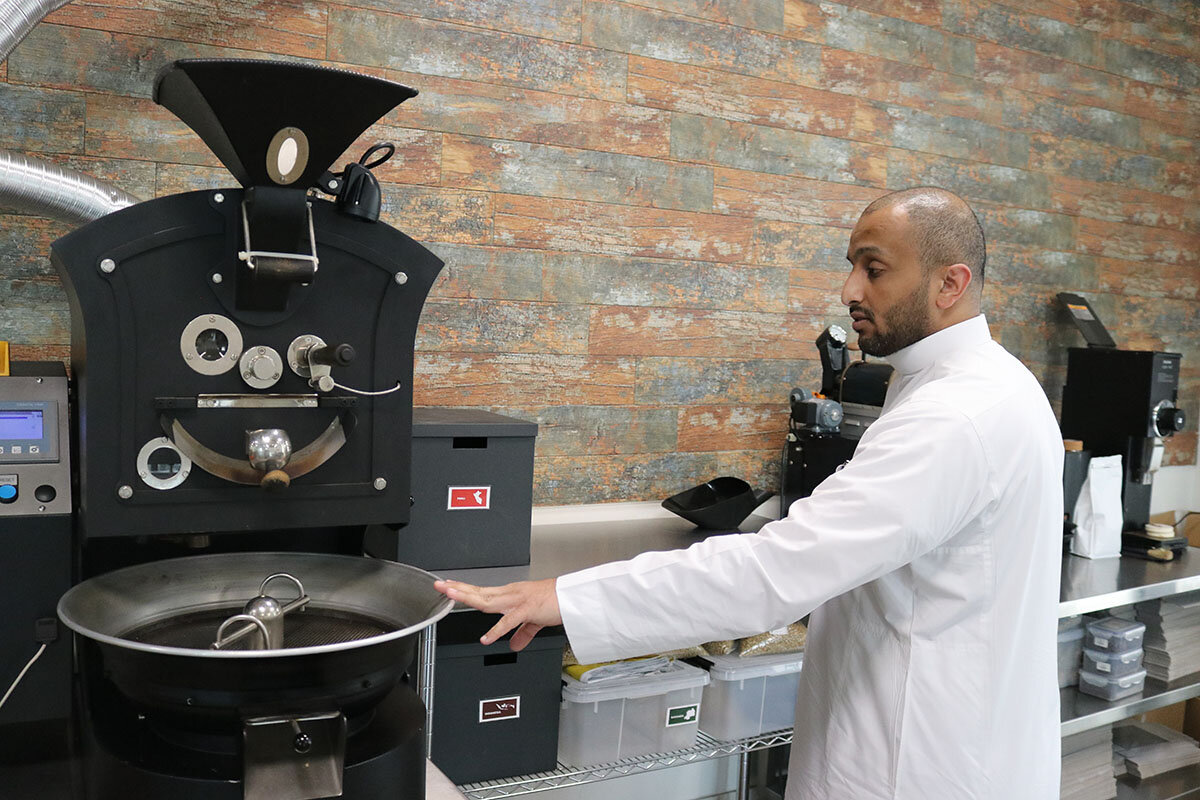
Kal Coffee, a Jeddah-based importer and wholesaler, and the kingdom’s first licensed coffee-quality evaluator, has witnessed a surge in demand for single-origin-sourced coffee from various countries, regions, elevations, and flavor profiles.
Most in demand? Homegrown.
“Saudis are appreciating a good cup of coffee,” says Abdullah Bagaba, director of Kal Coffee and a third-generation coffee trader, as an instructor trains two young baristas behind a glass wall.
“Before it was difficult to convince people to pay 20 riyals ($5.50) for a bag of coffee beans. But once they tried it, they noticed the difference in taste, and they are demanding it.”
Kal recently assessed a new brand of Jazan coffee.
“Frankly speaking, the results were stunning. They have very good coffee, and there is still huge room to improve,” Mr. Bagaba says.
“Specialty coffee is taking off in Saudi Arabia because we love complex flavors,” says Almohaned Almarwai, a Saudi coffee entrepreneur who co-owns Ash Cafe in Jeddah and is co-founder of the Arabian Coffee Institute, an industry consultant. “Coffee is embedded in our culture. Coffee is part of who we are as Saudis.”
At a cupping arranged at the institute’s training kitchen at the back of the buzzing Ash Cafe, Mr. Almarwai guides participants to sniff unmarked cups of coffee from seven countries, and then shows them how to slurp and swish the brew to hit their taste buds evenly.
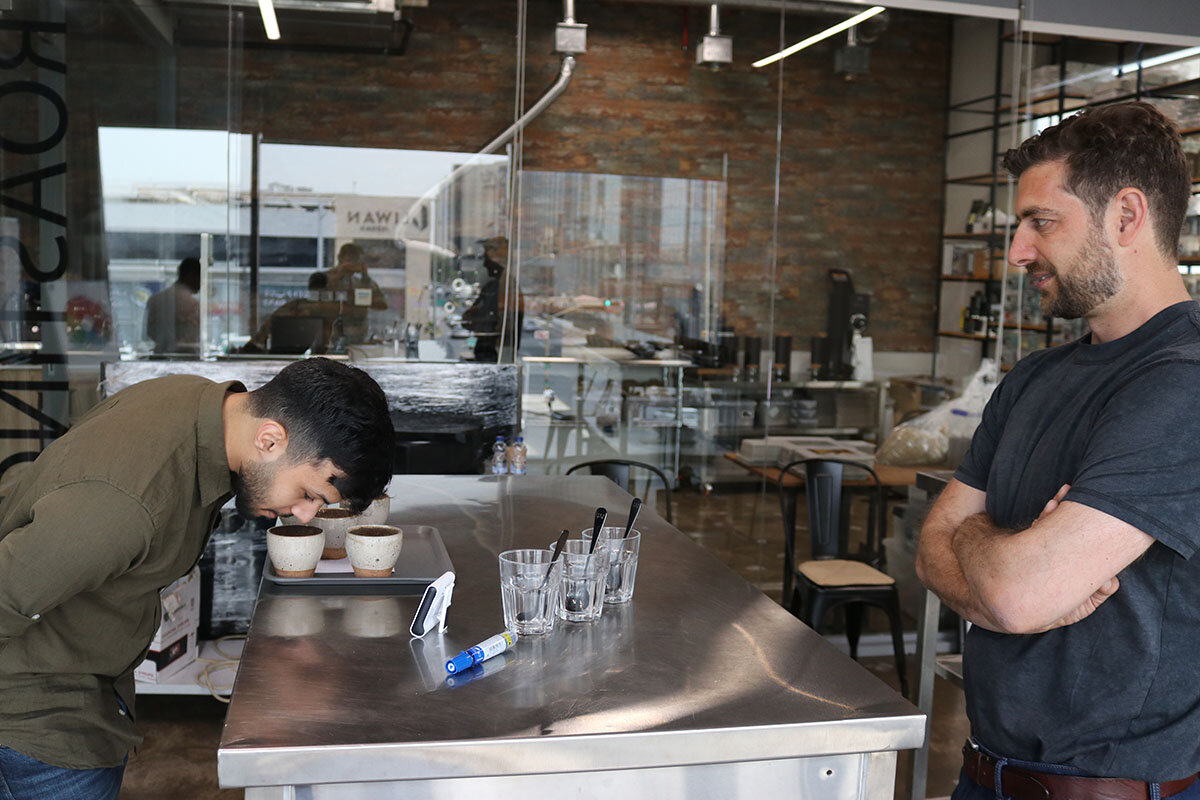
At the end of the tasting, the coffee revealed to be Saudi khawlani stood out with flavors of dried fruit, dates, chocolate, and caramel.
“It’s a complex cup, which is very desirable,” Mr. Almarwai says. “Production just can’t keep up with demand.”
The sought-after flavors of Saudi khawlani combined with an urge to serve homegrown coffee have led local coffee wholesalers, roasters, and cafes into bidding wars over the few hundred metric tons produced.
One kilogram of coffee (2.2 lbs) sold by Mr. Bani Malik in Jazan to wholesalers for $32 is eventually sold to consumers in Riyadh and Jeddah for $80-$110 a kilogram, or $36-$50 a pound. One ton of Saudi coffee is now 55 times more valuable than a ton of Saudi crude oil.
While the economics sort out, Jazan residents say maintaining their coffee’s communal role will eventually pave the path for khawlani beans from their mountains to your coffee cup.
“We hope to see Saudi coffee become a world brand, but we are focusing on getting our beans to market,” Mr. Bani Malik says. “So we can keep the dalleh flowing for guests.”

‘They welcome us’: Diverse running clubs attract more to sport
For people of color who want to run and feel safe, supported, and a sense of freedom, our reporter finds, it takes a community.

- Quick Read
- Deep Read ( 6 Min. )
At a recent meetup of members of Black Men Run and Black Girls Run! in Boston, organizer Jeff Davis asks the group why they showed up. Peace, gratitude, freedom, joy, and love are some of the responses.
The runners take a moment to remember those who came before them: ancestors; enslaved people who ran from those who enslaved them; Ahmaud Arbery, who was killed while on a run. “We run because they can’t,” Mr. Davis says.
These clubs are among several in the area working to change perceptions among community members, many of whom did not grow up in an environment that fostered distance or recreational running. Leaders aim to create opportunities that offer camaraderie and allow more people to feel the freedom and release that running provides.
“When people see us running down the street, people know who we are and they welcome us,” says Sidney Baptista, founder of Pioneers Run Crew.
Back at the joint event, a girl in a bright red shirt is sprinting alongside her father as she finishes her 5-mile loop in the Dorchester neighborhood. As the young runner crosses the finish line, arms raised in victory, Black Girls Run! leader Katonya Burke exclaims, “That’s it! There goes the next generation!”
‘They welcome us’: Diverse running clubs attract more to sport
When Sidney Baptista took up running almost a decade ago he knew he would need to find a daily route somewhere other than in his own neighborhood in Boston.
The tightly knit Cape Verdean community in Dorchester was home, but it didn’t offer the companionship of other runners. He would instead lace up his shoes and head to more affluent parts of Boston, like the Back Bay, Cambridge, and along the Charles River to practice his hobby. It became an escape, a gift for the mind, soul, and body, he says. And yet, the more he ran, the more he realized it didn’t make sense to shuttle to different neighborhoods just to run a few miles. When he tried to invite his friends and family, they always turned him down.
“People around me were like ‘What are you doing?’” he says. So instead, he brought the run to them.
Mr. Baptista launched the Pioneers Run Crew in 2017. Since then, he and his “team captains” have encouraged hundreds of new recruits and expanded a network of runners from diverse backgrounds throughout Boston. His group is one of several in the area working to change perceptions among community members, many of whom did not grow up in an environment that fostered distance or recreational running. Leaders aim to create opportunities that offer camaraderie and allow more people to feel the freedom and release that running provides.
“When people see us running down the street, people know who we are and they welcome us,” Mr. Baptista says of how far his group, with its brightly colored gear, has come.
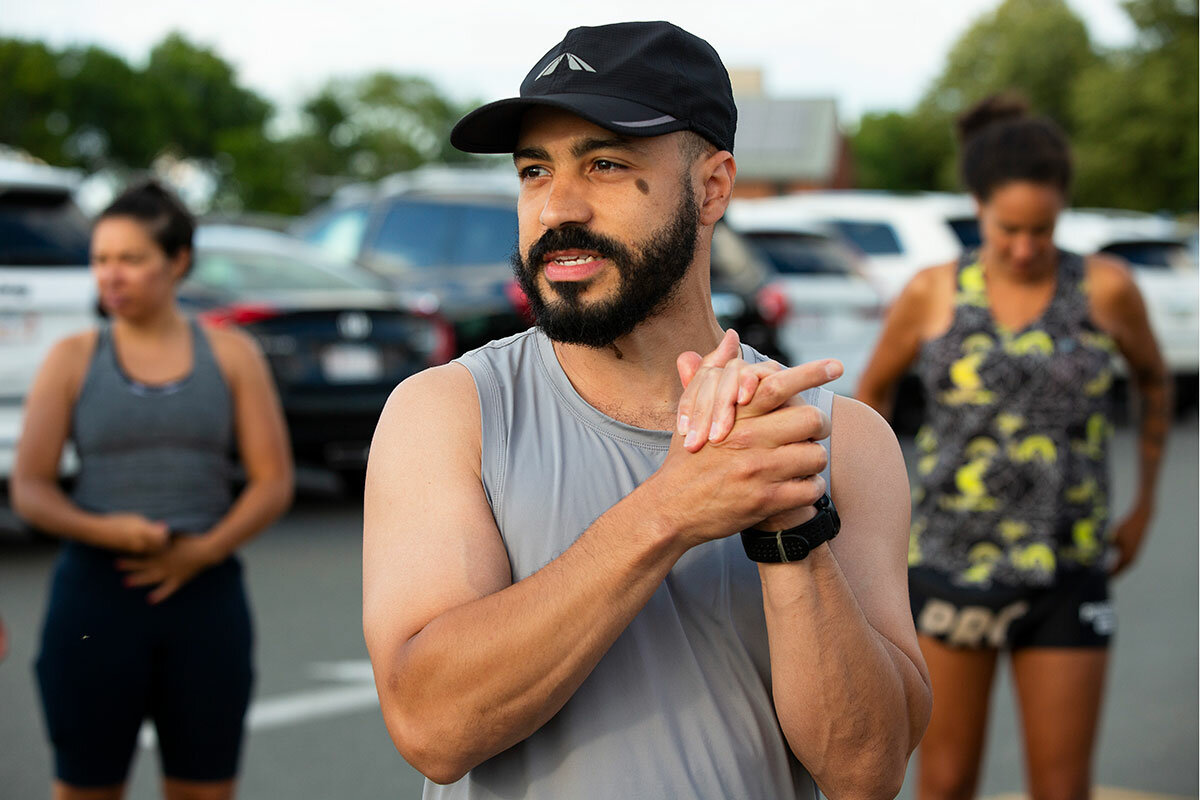
Only 4% of respondents to a 2020 survey by Running USA identified as Black. Athletes of color often steer toward basketball, football, and track in the hopes of “going pro,” Mr. Baptista, an entrepreneur and community organizer, says in an interview in his office in Dorchester. For many people in the neighborhoods he works with, long-distance running doesn’t hold that promise. He adds that national social inequalities and redlining have forced people of color to live in neighborhoods that don’t have the infrastructure, including properly maintained sidewalks, to support outdoor running. Safety – from traffic and sometimes crime – is also a concern.
Fear can also be an obstacle to running for Black people, says Katonya Burke, an ambassador in Boston for the national group Black Girls Run! They are sometimes concerned that they don’t have the right gear, or time, or people to run with. “The first step is to just do it, get out there and do it ... it’s the courage and dedication to start that matter,” she says.
Ms. Burke, along with other running advocates in Boston like Mr. Baptista and Jeff Davis, who founded the Boston chapter of Black Men Run, are working to change the views that keep people away.
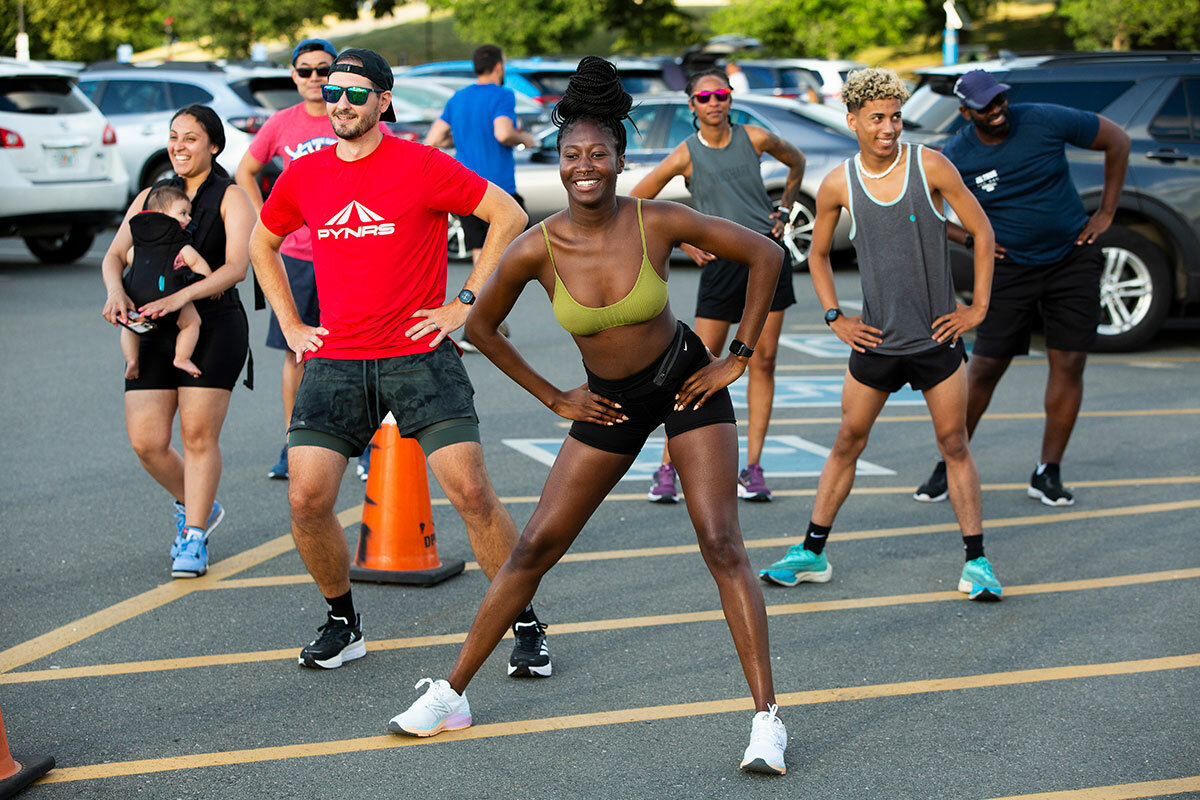
At a recent meetup between Ms. Burke’s and Mr. Davis’ groups in Dorchester, Tiffany Gayle Chenault, a sociology professor at Salem State University explained the importance of representation in running as she and a Monitor reporter chugged down a hill.
“When people think of runners, they don’t think of people who look like us,” says Ms. Chenault, who has studied gendered racism in white running spaces. When Americans think of runners, she says, they think of the East Africans who participate in and often win the Boston Marathon, or suburban white people exercising in their neighborhoods. “They don’t think of people who look like me.”
She says visibility is a way to address that. “It’s important to see other people who look like you breaking the barriers.”
Ms. Burke, of Black Girls Run!, is known in Boston’s Black running circuit for her joyful enthusiasm and ability to get even the most reluctant to hit the pavement. If people are able to relax their thoughts around running, it will be an easier and more fulfilling experience, she explains.
She knows something about resilience, as a truck driver, the single parent of a teenage son, and a six-time marathoner. While she has a running coach who supports her, she values the connections she has made through Black Girls Run! “I have lots going on in my world,” she says. “The ladies are a safe space. They allow me to see that I am not alone.”
This community support is happening in the city that is home to the Boston Marathon, one of the oldest (first held in 1897) and most famous running events in the United States. While women and people of color are increasingly among the throngs of amateurs who cross the finish line, the Boston Athletic Association (BAA) has only been collecting the racial demographics of its participants since 2021, says Adrienne Benton, who was recently the first woman of color to be appointed to the organization’s board of governors.
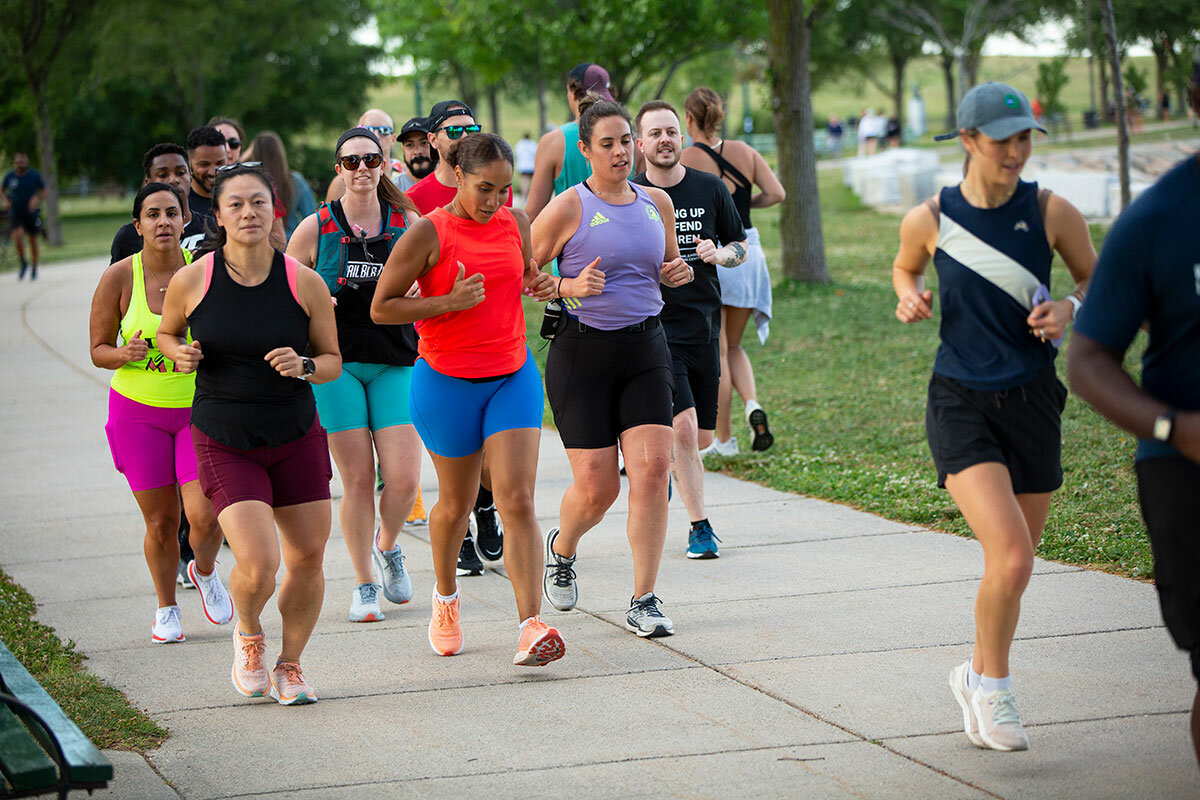
The BAA is making a conscious effort to curb the social inequalities that dissuade people from running, says Ms. Benton. Through its Boston Running Collaborative, the BAA has brought together existing organizations that support disenfranchised communities.
Local running organizers often emphasize that the camaraderie and shared experiences around running provide avenues for self-care. “Health and wellness in the Black community are not things we talk about enough,” says Mr. Davis of Black Men Run. “Especially mental health.”
The summer of 2020 was a turning point for Mr. Davis. The killings of George Floyd, Ahmaud Arbery, Tony McDade, and Breonna Taylor left him feeling enraged. Around the same time, he had to lay off 20 people from his company because of the economic downturn during the pandemic. “I was an emotional mess,” he says.
Then his wife suggested he participate in a community run. He enjoyed it so much he decided to organize a local chapter of Black Men Run. It’s a space where Black men can be together, support each other, and be themselves, he says. Every week they meet is an opportunity to grow together. “As long as we wake up and we’re Black, we run.” Mr. Davis says.
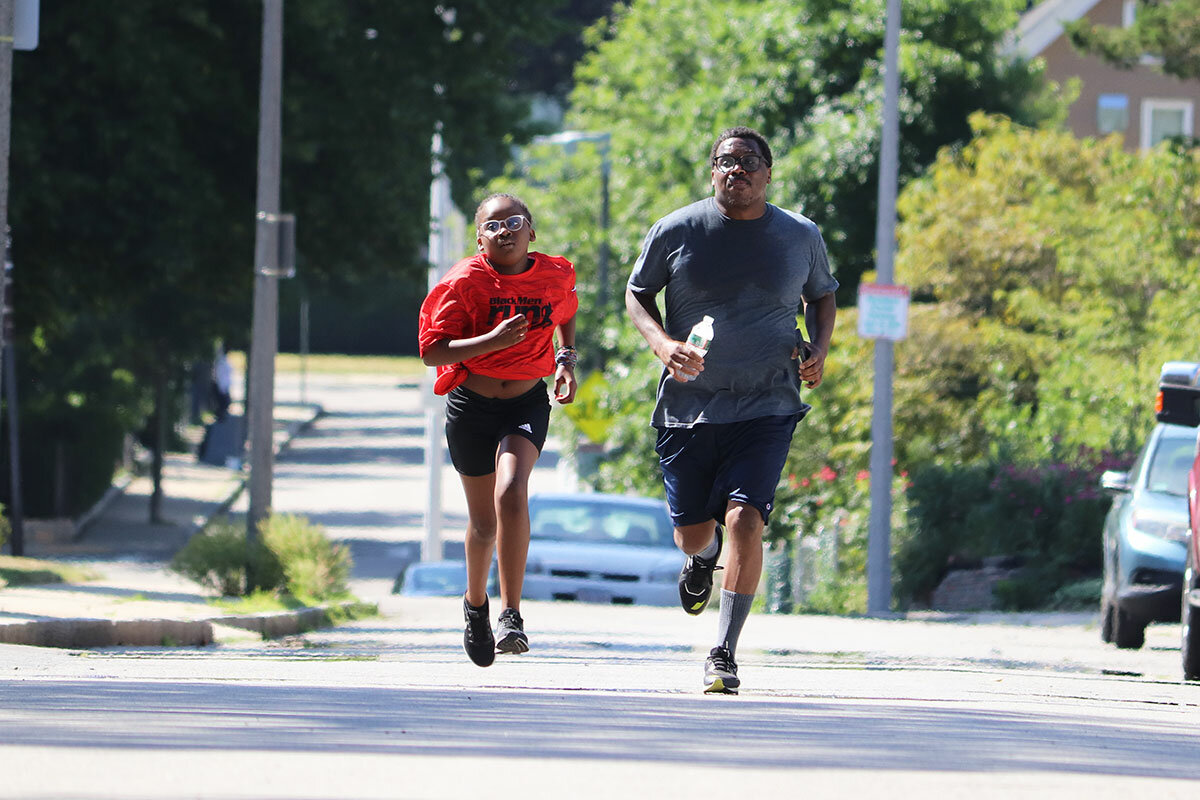
At the recent meetup in Dorchester of his crew and Black Girls Run!, Mr. Davis asks the group why they showed up. Peace, gratitude, freedom, joy, and love are some of the responses.
The group then takes a moment to remember those who came before them: ancestors; enslaved people who ran from those who enslaved them; Mr. Arbery, who was killed while on a run. “We run because they can’t,” Mr. Davis says to the group. For these athletes, it’s more than what happens on the pavement, it’s everything that they carry with them long after the cool down.
About an hour and a half later, as the runners return to the starting point, a young girl in a bright red shirt, Sekai Boyd, is sprinting with her father, Jason, beside her as she finishes her 5-mile loop. Loud applause erupts from the sidewalk as the group cheers her on. No one is louder than Ms. Burke – not even Sekai’s brothers who are watching their father struggle to keep up, a broad grin stretched across his face.
As the young girl crosses the finish line, arms raised in victory, Ms. Burke exclaims, “That’s it! There goes the next generation!”
Other headline stories we’re watching
(Get live updates throughout the day.)The Monitor's View
A crucial front against Russian intrusions
- Quick Read
- Deep Read ( 2 Min. )
-
By the Monitor's Editorial Board
Not far from the war front in Ukraine lies another front – a nonviolent one – against another type of Russian intrusion on one of its European neighbors. It lies inside Bulgaria, a country that for most of this year worked hard to end Moscow’s malign influence on its democracy and create clean governance in the European Union’s most corrupt member state.
That effort in the Black Sea nation began last year after mass anti-corruption protests brought to power a Harvard-trained reformer, Kiril Petkov. The new prime minister quickly put in place many anti-corruption measures and shone a bright light on corrupt practices by organized crime. After the brutal invasion of Ukraine, he also ended a long tradition of pro-Moscow leanings among Bulgarian politicians.
Yet by late June, Moscow’s hand in Bulgarian politics reemerged. Mr. Petkov’s ruling coalition collapsed. He blamed the Russian ambassador. Now the country is heading to the polls for what will again be a test for ending the two sides of the same coin: Russian meddling and high-level corruption.
Bulgaria’s victories have become almost as important as Ukraine’s.
A crucial front against Russian intrusions

Not far from the war front in Ukraine lies another front – a nonviolent one – against another type of Russian intrusion on one of its European neighbors. It lies inside Bulgaria, a country that for most of this year worked hard to end Moscow’s malign influence on its democracy and create clean governance in the European Union’s most corrupt member state.
That effort in the Black Sea nation began last year after mass anti-corruption protests brought to power a Harvard-trained reformer, Kiril Petkov. The new prime minister quickly put in place many anti-corruption measures and shone a bright light on corrupt practices by organized crime. After the brutal invasion of Ukraine, he also ended a long tradition of pro-Moscow leanings among Bulgarian politicians.
In April, for example, Mr. Petkov stood up to bullying by President Vladimir Putin, which led to a cutoff of Russian natural gas supplies to Bulgaria. He quickly lined up gas supplies from the United States and elsewhere. “We needed to show that ... no one can blackmail the democratic world,” he told Euractiv news site.
Soon after, he expelled 70 diplomats and staff of the Russian Embassy on suspicion of meddling in Bulgaria. He also defied Moscow by helping North Macedonia move closer to EU membership. And he provided aid to Ukraine’s military, even visiting the country and witnessing a Russian military attack.
The invasion and Mr. Petkov’s reforms seemed to have transformed his country. “Bulgarians have experienced a European awakening, with many of them now feeling that they truly belong in the EU family,” wrote Maria Simeonova of The European Council on Foreign Relations.
Yet by late June, Moscow’s hand in Bulgarian politics reemerged. Mr. Petkov’s ruling coalition collapsed when one party pulled out, bringing in a caretaker government until an election slated for Oct. 2. He blamed the Russian ambassador.
“Russia really wants to take down this government because it will show that if you don’t play with them, then governments fall,” he told The Guardian.
Now the country is heading to the polls for what will again be a test for ending the two sides of the same coin: Russian meddling and high-level corruption. The election will measure “the integrity of the European Union – integrity in terms of both unity and ethical values,” Mr. Petkov wrote in The FCPA Blog.
Bulgaria’s victories have become almost as important as Ukraine’s.

A Christian Science Perspective
Each weekday, the Monitor includes one clearly labeled religious article offering spiritual insight on contemporary issues, including the news. The publication – in its various forms – is produced for anyone who cares about the progress of the human endeavor around the world and seeks news reported with compassion, intelligence, and an essentially constructive lens. For many, that caring has religious roots. For many, it does not. The Monitor has always embraced both audiences. The Monitor is owned by a church – The First Church of Christ, Scientist, in Boston – whose founder was concerned with both the state of the world and the quality of available news.
Protected from the effects of accident
- Quick Read
- Read or Listen ( 3 Min. )
-
By Karen Neff
No matter what kind of circumstance we may be facing, God is here to inspire, protect, and heal – as a woman experienced when a kitchen stove mishap quickly turned dangerous.
Protected from the effects of accident
Is it reasonable to look to God for protection and healing in our daily lives?
I discovered that it is, and with good results, one day after setting a pan of water with a pat of butter in it on the stove to simmer. I stepped away and when I returned, the water had evaporated and the kitchen was filled with smoke. I picked up the pan and carried it outside. Without thinking, I lifted the lid off, and the remaining butter burst into flames that covered my face, neck, and arm and set my shirt on fire.
As I dropped the pan and patted the flames out, I felt surprisingly calm. Above all, I felt grateful for inspiring ideas that had come to me during my prayer and spiritual study earlier that day. They had helped me realize that our loving Father-Mother, God, protects and preserves us from anything that would seem to go against our identity as God’s children, spiritual and whole.
Evidence contrary to that spirituality and wholeness is understood in Christian Science to be an aggressive mental suggestion, because God, perfect Love, could never make or allow anything that could injure, impair, or harm. God’s creation is the outcome of God’s own perfection; God’s children enjoy the perpetual safety of His blessings, which keep us exempt from danger, and in which no one is at the mercy of sudden, untoward experiences. Accidents can’t occur in the infinite realm of divine Love, where we are enveloped, enfolded, and encompassed in God’s care. Psalm 91 calls this “the secret place of the most High” (verse 1).
This spiritual reality is the basis for rejecting as legitimate any seeming effects from an accident. God has given us dominion over whatever would seem to contradict the spiritual reality. The Christ, God’s healing truth and love that Jesus demonstrated, empowers us to demonstrate this.
This understanding was my authority to take a strong, spiritual stand and claim my exemption from harm even when the situation was flaring up in my face. I felt fortified by divine Truth. Although there were burns on my skin, I felt no pain.
“Science and Health with Key to the Scriptures” by Mary Baker Eddy, the discoverer of Christian Science, describes how to apply this approach of overcoming an apparent impact from accidents based on understanding the divine reality of our being: “Declare that you are not hurt and understand the reason why, and you will find the ensuing good effects to be in exact proportion to your disbelief in physics, and your fidelity to divine metaphysics, confidence in God as All, which the Scriptures declare Him to be” (p. 397). As I silently prayed, my confidence in the allness of God, good, grew. The pinkness of the skin was already fading, and I was able to finish preparing dinner as if nothing had happened. And very soon, my skin showed no trace of the accident.
The Bible says of God, “Before they call, I will answer” (Isaiah 65:24). This experience has inspired me to pray more assiduously for others who find themselves caught in harmful circumstances that seem beyond their control. How grateful I am to know that the same love of God that helped me is here to help everyone. It’s heartening to know that God, Love itself, is always present to inspire in us the ideas that lead us to safety and guide us effectively.
We can all follow Christ Jesus’ example of turning consistently and wholeheartedly to God for rescue and healing, whatever the need.

A message of love
One hundred years of first days

A look ahead
Thanks for joining us. Come back tomorrow: We’re working on a story about getting books by Latino authors into readers’ hands, including books that have been banned.




